| Technologies
and Services
of Digital Broadcasting
(2) |
Source
Coding
-High-efficiency coding
of video signals-
|
| "Technologies
and Services of Digital
Broadcasting" (in
Japanese, ISBN4-339-01162-2)
is published by CORONA
publishing co., Ltd.
Copying, reprinting,
translation, or retransmission
of this document is
prohibited without
the permission of
the authors and the
publishers, CORONA
publishing co., Ltd.
and NHK. |
| 1.
Fundamentals of high-efficiency
coding |
|
Digitizing a television
signal in its original
form produces a huge amount
of information. For example,
digitizing the NTSC signal
that is currently used
in Japanese broadcasting
results in a data rate
of 100 Mbps, with a standard
definition television
component signal and an
HDTV production standard
signal resulting in about
216 Mbps and 1.2 Gbps,
respectively. Transmitting
this amount of information,
which is at least 1000
times as much as an audio
signal, requires a broadband
transmission path, and
recording it requires
large-capacity storage
equipment.
A picture signal, however,
possesses multidimensional
redundancy. In addition
to the strong two-dimensional
correlation between adjacent
picture elements (pels)
over space, there is also
correlation along the
time axis. A good degree
of data compression can
be expected by using such
statistical properties
of a picture to eliminate
redundant sections.
Against the above background,
high-efficiency coding
has been researched for
many years with the aim
of achieving efficient
transmission or storage
of picture signals (especially
television signals) by
reducing their redundancy.
The following overviews
the properties of video
signals in conjunction
with their supporting
role in the design of
coding systems, and describes
the framework for compression
processing using those
properties.
[1] Statistical properties
of video signals
A great deal of data has
been presented in relation
to the statistical properties
of television signals
and other kinds of picture
signals, and models of
such signals have been
constructed on the basis
of that data.
(1) Amplitude distribution
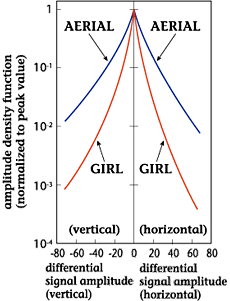 |
| Figure
1: Difference-signal
distribution between
adjacent pels |
 |
 |
| Figure
2: Measurement of
difference-signal
amplitude distribution
between frames |
Due to the ease of measuring
the amplitude distribution
of a picture signal, many
examples of such measurements
can be found. It is intuitively
clear, however, that such
measurements are extremely
dependent on the picture
itself and can vary greatly
according to shooting
conditions. For a television
signal, moreover, the
non-linearity of the picture
tube is corrected (gamma
correction) at the camera,
which means that the amplitude
distribution in camera
output will be somewhat
different from the optical
intensity distribution
of the original picture.
Rigorous modeling is therefore
difficult to achieve,
but it is possible to
use a uniform distribution
as a first-order approximation
showing the aggregate
average of many pictures.
Picture coding is often
carried out using difference
signals in the picture instead
of amplitude itself. This
is because the high correlation
of the picture signal means
that difference in amplitude
between (spatially or temporally)
adjacent pels is frequently
small. Figure 1 shows an
example of a difference-signal
distribution between adjacent
pels and Fig. 2 shows an
example of the amplitude
distribution of the difference
signal in the temporal direction,
i.e., between frames. As
shown by these figures,
the amplitude density function
of the difference signal
is nearly a double-sided
exponential distribution
(Laplace distribution) as
given by Eq. (1).
 |
(1) |
(2) Correlation function
and power spectrum
When the statistical properties
of picture information g(x,
y) are invariable with respect
to screen position, that
picture information is called
"spatially stationary."
The autocorrelation function
for stationary two-dimensional
picture information is defined
as follows.
 |
(2) |
This indicates the strength
of the spatial correlation
between two points separated
by a displacement of .
Kretzmer was the first to
actually measure a picture's
autocorrelation function
using optical means. Results
of that measurement are
shown in Fig. 3. Many subsequent
measurements exhibited similar
behavior. As shown by the
figure, the correlation
between adjacent pels is
normally high despite the
fact that correlation differs
according to picture content.
This characteristic can
be approximated one-dimensionally
as follows.
 |
(3) |
It can also be expressed
two-dimensionally as
 |
(4) |
or
 |
(5) |
Equation (4) is called the
"circularly symmetric model"
and Eq. (5) the "separable
model." We point out here
that horizontal and vertical
correlation is somewhat
stronger than diagonal correlation
in ordinary pictures as
reflected by structures
and natural objects like
the horizon. For this reason,
the separable model of Eq.
(5) is considered to be
closer to reality.
For the separable model,
we consider a grid-shaped
sample and express the correlation
function between pels separated by
m pels horizontally and
n pels vertically as follows,
where the interval between
sample points is taken to
be x0, y0.
between pels separated by
m pels horizontally and
n pels vertically as follows,
where the interval between
sample points is taken to
be x0, y0.
 |
(6) |
A random signal process
that satisfies a condition
like this is called a first-order
Markov process.
While the autocorrelation
function expresses the properties
of picture information in
the spatial domain, power
spectral density (referred
to as simply "power spectrum"
below) expresses picture
properties in the spatial
frequency domain. The two-dimensional
power spectrum of a picture
is denoted as  and defined as follows.
and defined as follows.
 |
(7) |
It is known that this power
spectrum and correlation
function  constitute a Fourier transform
pair according to the Wiener-Khintchine
theorem. This means that
a signal with high autocorrelation
like a picture signal concentrates
power in the low-frequency
domain. Letting
constitute a Fourier transform
pair according to the Wiener-Khintchine
theorem. This means that
a signal with high autocorrelation
like a picture signal concentrates
power in the low-frequency
domain. Letting  , ,
 , and
, and  in Eq. (5), the two-dimensional
power spectrum becomes after
a Fourier transform.
in Eq. (5), the two-dimensional
power spectrum becomes after
a Fourier transform.
 |
(8) |
The above deals with
two-dimensional signals
like still pictures, but
there is also a three-dimensional
autocorrelation function
 derived by Conner and
Limb that deals with moving
picture signals. In this
regard, they created a
model of a moving picture
signal that considers
object speed or the camera's
aperture effect, accumulation
effect, etc., and derived
autocorrelation based
on that model. They also
showed that spatial correlation
along the direction of
motion increases as object
speed increases, but that
temporal correlation decreases.
derived by Conner and
Limb that deals with moving
picture signals. In this
regard, they created a
model of a moving picture
signal that considers
object speed or the camera's
aperture effect, accumulation
effect, etc., and derived
autocorrelation based
on that model. They also
showed that spatial correlation
along the direction of
motion increases as object
speed increases, but that
temporal correlation decreases.
Miyahara has also measured
the spectrum of the inter-frame
difference signal. It
was found that the autocorrelation
function of this signal
derived from that measurement
deviates slightly from
the exponential function
of Eq. (3).
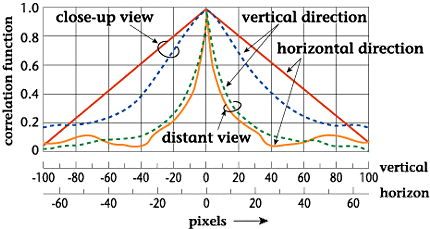 |
| Figure
3: Results of measuring
the autocorrelation
function |
[2] Redundancy and
compression
As described in section
[1], a picture signal
generally has high inter-pel
correlation and includes
many redundant components.
Removing these redundant
components should make
it possible to represent
a signal in an optimal
fashion and compress information.
Redundancy based on the
statistical properties
described above is called
"statistical redundancy,"
and how to reduce it is
the basis for designing
a high-efficiency coding
process.
Another form of redundancy
targeted for reduction
by high-efficiency coding
is "visual redundancy."
This kind of redundancy
is based on human visual
characteristics such as
the following.
| - Visibility with
respect to resolution
in a diagonal direction
is lower than that
in the horizontal
or vertical direction |
| - Visibility with
respect to high-frequency
components is lower
than that of low-frequency
components |
| - Visibility with
respect to moving
objects is lower than
that of stationary
objects |
Visual redundancy is
used in analog bandwidth-reduction
techniques as exemplified
by MUSE (Multiple Sub-Nyquist
Sampling Encoding). In
digital data-compression
techniques, statistical
redundancy and visual
redundancy are cleverly
reduced to achieve high
compressibility.[3] Basic coding/decoding
process
The basic picture coding/decoding
process including picture
input and output is shown
in Fig. 4. This process
begins with an analog/digital
converter (A/D) converting
the picture signal output
from a photoelectric converter
such as a camera to a
two-dimensional or three-dimensional
digital data array. Each
element of this array
represents a sample of
the picture in question
and is called a "picture
element," or "pel" for
short. This data array
includes many redundant
components, and the source
coder can remove nearly
all of these redundancies.
The data array is passed
through a channel coder
that adds previously established
fixed-redundant components
such as error-correction
codes to increase the
reliability of transmission
or of the storage medium.
Note that high efficiency
coding here generally
means source coding.
 |
| Figure
4: Basic steps of
the picture coding/decoding
process |
The source-coding process
is shown in Fig. 5. The
first step in the process
is signal conversion.
Making use of video characteristics
(statistical redundancy),
this step converts the
signal into data having
a distribution as biased
as possible, decreases
entropy, and extracts
only information that
must be coded. In principle,
this process is not accompanied
by distortion. Next, quantization
approximates the extracted
data to a finite number
of discrete levels and
decreases entropy even
further. This process,
on the other hand, is
irreversible and accompanied
by distortion. It is common,
however, to make use of
visual characteristics
(visual redundancy) to
manipulate the data in
such a way as to decrease
the amount of subjective
distortion as much as
possible. Finally, in
code allocation, the system
allocates optimal binary
codes to the symbols output
by quantization so that
the average code length
of coded output approaches
the entropy of those symbols.
This is a reversible process
without distortion.
It should be mentioned
here that the constituent
elements in the above
processes are not designed
independently of each
other, and that there
are techniques for combining
two constituent elements.
 |
| Figure
5: Source-coding process |
| 2.
Elemental technologies |
|
[1] Predictive coding
As described above, a
picture signal exhibits
high correlation and the
difference between adjacent
pels is generally small.
It is therefore more efficient
to transmit differences
with respect to what has
already been transmitted
than to transmit the signal
directly. This kind of
coding system is called
"predictive coding" (of
which differential pulse-code
modulation (DPCM) is nearly
a synonym).
To be more specific, a
predictive-coding system
stores previous pel values
that have already been
coded in a memory within
the coder, and computes
a prediction value x'
for pel x that is to be
input. The system then
quantizes the difference
x-x' (prediction error),
allocates a code to the
result, and transmits
the code. On the receiver
side, the system first
generates a prediction-error
signal from transmitted
codes and then adds that
signal to the immediately
previous picture signal
that has already been
decoded to obtain a new
picture signal. The function
that calculates prediction
values is called a "predictor."
The In moving picture
coding, it is effective
to perform prediction
based on pels of the prior
field or prior frame.
These processes are called
"inter-field prediction"
and "inter-frame prediction,"
respectively. In this
regard, frequently only
a small part of the picture
displays motion, for example,
a scene showing an airplane
flying across the sky.
In this case, it is most
efficient to extract the
moving areas from the
magnitude of the inter-frame
prediction-error signal
and to transmit a prediction-error
signal only for those
areas (called "conditional
replenishment"). With
this method, however,
coding efficiency rapidly
deteriorates as moving
areas increase. To combat
this problem, the motion
quantities (motion vector)
of a moving object can
be estimated by some method
and inter-frame prediction
performed after compensating
for that amount of motion.
This method is called
"motion-compensation (MC)
prediction." Motion estimation
methods include the block-matching
method and the gradient
method, with the former
finding widespread use
at present.
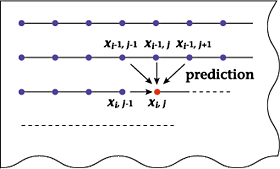 |
| Figure 6: Example of predictive coding (intra-field
prediction) |
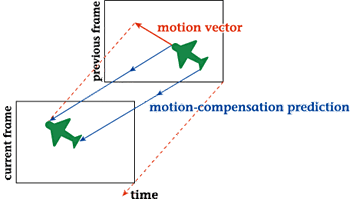 |
| Figure 7: Principle of motion-compensation
prediction |
[2] Orthogonal transform coding
In terms of the frequency
domain, the fact that
an ordinary picture signal
exhibits high correlation
means that power concentrates
in low-frequency components.
Accordingly, coding and
transmitting the magnitudes
(coefficients) of only
low-frequency components
where power concentrates
should make it possible
to achieve an overall
reduction in the amount
of information.
A method called "transform
coding" linearly transforms
a correlated signal into
a signal having as little
correlation as possible,
and uses the fact that
power concentrates in
specific transform coefficients
to optimize the amount
of information allocated
to each coefficient. This
process results in an
overall reduction in coded
information.
In actuality, it is common
to divide the image into
blocks of appropriate
sizes and to transmit
the picture signal after
performing an orthogonal
transformation on each
block and quantizing coefficients.
Various proposals have
been made for the transform
bases (waveforms) used
in orthogonal transform
coding, with two well-known
ones being the Hadamard
transform that is easy
to implement in hardware
and the Karhunen-Loeve
(KL) transform that is
most efficient in principle
(though not easy to implement).
In recent years, however,
the discrete cosine transform
(DCT) has found widespread
use as it can achieve
characteristics near those
of the KL transform for
ordinary picture signals.
Its adoption has also
been spurred by the growing
ease of implementing DCT
processes in LSI devices
as circuit technologies
continue to progress.
(1) DCT
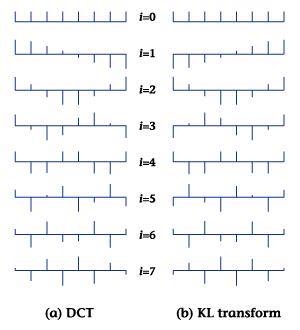 |
| Figure
8: Transform bases |
Figures 8(a) and 8(b)
show transform bases for
DCT of block-length 8
and those for the KL transform
of a picture signal approximating
a first-order Markov model
and having an adjacent-pel
correlation of 0.95. As
can be seen, these two
sets of transform bases
are in near agreement.
It can also be theoretically
shown that the KL transform
approaches DCT as the
correlation coefficient
approaches 1.0 in the
first-order Markov model.
Figure 9 shows an example
of DCT coding for a one-dimensional
sequence of video-signal
values. In this process,
the video signal is transformed
into an array of component
magnitudes (coefficients)
corresponding to each
of the DCT transform bases.
In general, the components
for the bases expressing
low frequency, which are
positioned towards the
top of the figure, have
large magnitudes. A relatively
large amount of information
is therefore allocated
to these components while
a relatively small amount
of information is allocated
to high-frequency components.
This makes it possible
to represent a video signal
with less information
overall than is used to
represent the original
signal sequence. On the
decoding side, the video
signal is reconstructed
by performing a linear
summation of the coefficient-weighted
transform bases received
from the coding side.
Because a picture signal
has high correlation in
both the horizontal and
vertical directions, it
is common practice to
perform a two-dimensional
DCT in these directions
using a 8-pel-horizontal
by 8-pel-vertical block.
The DCT exhibits nearly
optimal characteristics
in the sense that it concentrates
power in certain coefficients
(coefficients corresponding
to low-frequency bases),
as described above. On
the other hand, DCT can
also be a cause of picture
degradation due to features
like block distortion
and mosquito noise, as
described below.
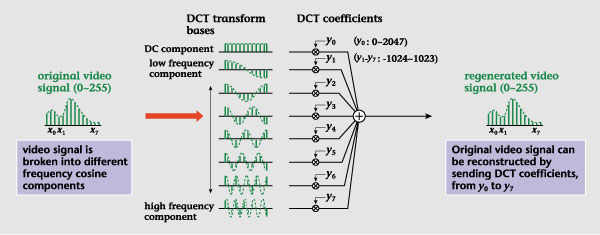 |
| Figure
9: Example of DCT
coding (1 dimensional
process) |
(2) LOT
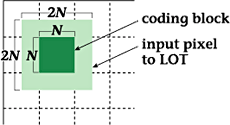 |
| Figure
10: LOT basis area |
Coding that performs
transformations in units
of blocks as in DCT can
be a source of visual
degradation called "block
distortion" in which block
structures can be seen
in the decoded picture
when the DCT is given
an insufficient amount
of information. To prevent
this from happening, methods
like the lapped orthogonal
transform (LOT) and wavelet
transform are being studied.
The former transform,
which uses bases representing
the overlapping of transform
bases at adjacent blocks
(Fig. 10), is described
first.
In LOT, N*N transform
coefficients are determined
from the pel values of
a 2N*2N block, and overlapping
of this block with adjacent
blocks therefore occurs
for N/2 pels at the top,
bottom, left, and right.
On the decoding side,
a 2N*2N block of pels
is reconstructed, and
the overlapping sections
are added on. This process
ensures continuity between
adjacent blocks and reduces
block distortion.
In deriving the bases used
in LOT, the bases of overlapped
adjacent blocks are assumed
to be orthogonal DCT bases.
Establishing this condition
maintains the key DCT feature
of concentrating power.
Nevertheless, with LOT and
the wavelet transform described
below, block-wise discontinuities
may occur in the signal
targeted for transformation,
due to block-by-block processing
for motion compensation
or other reasons. To solve
this problem, overlapping
motion compensation has
been proposed.
(3) Wavelet transform
In DCT coding, the existence
of discontinuities like
sharp edges within a block
can result in the appearance
of ringing artifacts called
"mosquito noise" or "corona
effects" around those
edges. This kind of visual
degradation occurs because
a local change affects
the entire transform block
due to the use of transform
bases that have the same
length from low to high
frequencies. The wavelet
transform, on the other
hand, features a short
transform basis length
for high-frequency components
compared with that for
low-frequency components.
This lowers the effect
of local changes with
respect to high frequencies
and suppresses the occurrence
of mosquito noise.
In frequency analyses
such as a Fourier transformation,
it is not known where
a change in the signal
has occurred. The wavelet
transform, however, does
allow analysis in both
the frequency and temporal
domains and uses transform
bases that are localized
in time.
In general, "wavelets"
are expressed as a set
of functions as in Eq.
(9) that can scale by
a factor of a (scale transform)
or shift by a factor of
b (shift transform) the
"basic wavelet" function
 , which is to be localized
in either time or frequency.
, which is to be localized
in either time or frequency.
 |
(9) |
Equation (9) can be used
to extract time and frequency
components from a signal
in accordance with parameters
a and b in an operation
called a "wavelet transform."
As a becomes larger, that
is, as frequency becomes
higher, the width of the
waveform becomes smaller,
temporal resolution increases,
and frequency resolution
decreases (Fig. 11).
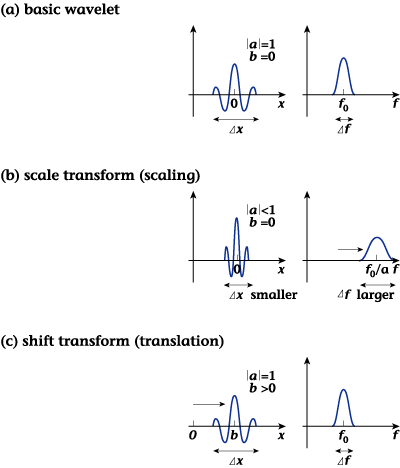 |
| Figure
11: Wavelet transform |
Figure 12 compares the
transform bases of the
wavelet transform with
those of DCT. As mentioned
above, the wavelet transform
can suppress the spread
of high-frequency mosquito
noise in areas near object
edges or the like where
the signal changes sharply.
Moreover, in a manner
similar to LOT, adjacent
transform bases overlap
in a wavelet transform
and block distortion will
not, in principle, appear.
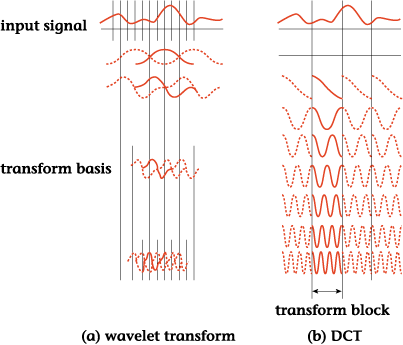 |
| Figure
12: Comparison of
transform bases between
the wavelet transform
and DCT |
The wavelet transform
can be implemented as
a filter bank that recursively
divides the low-frequency
area, as shown in Fig.
13. In other words, the
wavelet transform can
be treated as a high-pass
filter in which a certain
frequency band is extracted
and low-frequency components
are thinned out in a ratio
of 2:1 for another round
of filtering. This thinning-out
operation is equivalent
to extending the previous
basis function by two
times, and repeating this
operation makes it possible
to extract low-frequency
components from high-frequency
components in a stepwise
manner.
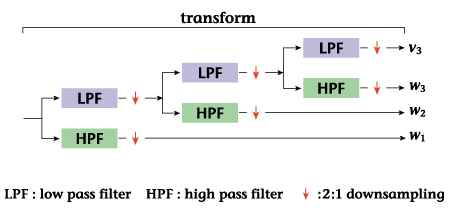 |
| Figure
13: Implementation
of the wavelet transform
by a filter bank |
[3] Vector quantization
Vector quantization is
a method that represents
a group of pels in vector
form and performs an optimal
quantization of that vector.
In this method, coding
efficiency near the theoretical
limit can be achieved
by increasing the dimension
of the vector. Doing so,
however, rapidly increases
the amount of coding processing,
so a vector dimension
of 16 corresponding to
a group of 4 horizontal
pels * 4 vertical pels
is typically chosen as
a realistic compromise.
The coding procedure is
as follows. The system
first divides the image
into blocks of 4*4 and
compares each block with
a previously prepared
set of standard pel patterns
called a codebook. Then,
for each block, the system
sends an index value corresponding
to the pattern that best
approximates that block.
On the decoding side,
the system reproduces
the pattern corresponding
to the received index
value using the same codebook
as the coding side.
Figure 14 compares vector
quantization with scalar
quantization, which quantizes
each pel individually.
In particular, Fig. 14(a)
shows the result of performing
scalar quantization on
two pels individually,
while Fig. 14(b) shows
the manner of quantization
that can be achieved by
performing a vector quantization
that treats x0
and x1 as a pair
in the form of a two-dimensional
vector. Dividing the signal
space multidimensionally
in this way can reduce
overall quantization distortion.
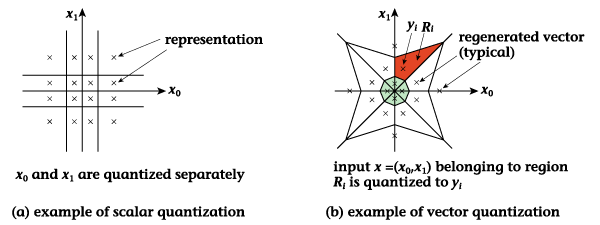 |
| Figure
14: Comparison of
vector quantization
and scalar quantization |
On the other hand, deriving
a method for designing
a compact and highly general
codebook and reducing
the amount of quantization
computation and required
memory are important issues
in vector quantization.
As a means of dealing
with the former issue,
the so-called Linde-Buzo-Gray
(LBG) algorithms developed
by Linde et al. are known.
As for the latter issue,
it has already been mentioned
that because of processing
and memory restrictions,
a 16-dimensional 4*4 vector
is currently considered
to be the upper limit.
Even at this dimension,
however, a huge number
of computations are needed
to ensure good-quality
reproduction. Various
solutions to this problem
have been proposed. One
is the "tree search algorithm"
that uses a hierarchically
arranged codebook corresponding
to the division of signal
space into levels to reduce
the amount of computation
up to the output vector
of the final node. Another
is "mean-separation normalized
vector quantization" that
performs vector quantization
after first subjecting
an input picture signal
to mean separation and
normalization and then
converting it to a standard
probability distribution.
[4] Subband coding
The subband coding technique
first divides the input
signal into a number of
separate bands through
the use of filters, and
then codes the picture
of each band individually.
Using subbands in this
way makes it possible
to allocate an appropriate
amount of information
to each band and to control
the frequency distribution
of the distortion. In
other words, subband coding
allows for coding control
that considers not only
the power spectrum distribution
of the picture signal
but also the characteristics
of human vision. In addition,
the ability of forming
a hierarchy in the frequency
domain means that subband
coding can be used as
a resolution-conversion
technique when transmitting
picture signals between
systems of different resolutions
and as a technique for
achieving graceful degradation.
An example of a subband-coding
procedure is shown in
Fig. 15. On the coding
side, the system divides
the input signal into
separate bands using analysis
filters and performs downsampling
in accordance with the
bandwidths in question.
On the decoding side,
the system synthesizes
the picture after performing
upsampling.
 |
| Figure
15: Example of a subband-coding
procedure |
In addition to one-dimensional
division, subband division
is also capable of two-dimensional
division in the horizontal
and vertical directions
as well as three-dimensional
division that includes
the temporal direction.
Two-dimensional division,
however, is the most common.
To raise coding efficiency
here, DPCM, orthogonal
transform, or other coding
methods may be used to
code the divided signals.
Further division of these
signals, moreover, can
eliminate spatial redundancy
and allows for a configuration
that negates the need
for orthogonal transform
or the like. In this case,
either all bands are further
divided or only low-frequency
signals are recursively
divided. A technique that
adaptively changes the
method of division according
to picture content has
also been proposed. Coding
only by band division
features no block distortion
as seen in orthogonal
transform coding. Similar
to LOT, however, it is
not highly compatible
with adaptive processing
in block units, and some
sort of measure to deal
with this problem is required.
Types of subband filters
include the quadrature
mirror filter (QMF) and
the symmetric short kernel
filter (SSKF).
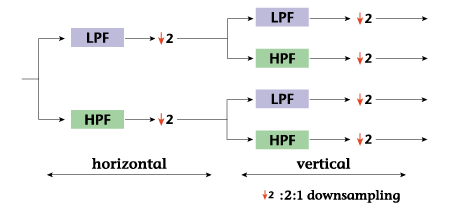 |
| Figure
16: Two-dimensional
subband division |
[5] Entropy coding
Entropy coding shortens
the average code length
with respect to the source
output having a finite
number of symbols. It
does this by using occurrence
probability to allocate
short code words to symbols
with high frequencies
of occurrence. This is
an information-preservation
type of coding that uses
only statistical properties.
(1) Huffman coding
Given the occurrence frequency
of coded objects (here,
output values of quantization),
Huffman coding minimizes
the average code length
by allocating codes of
optimal code length according
to frequency of occurrence.
Taking orthogonal transform
coding as an example,
the output values of quantizing
the coefficients of low-frequency
components are large while
a high probability exists
that the output value
of quantizing a coefficient
of a high-frequency component
is zero. With this in
mind, we start from a
DC level in a two-dimensional
DCT and extract quantization
levels by zigzag scanning
in the horizontal and
vertical directions toward
high-frequency components,
as shown in Fig. 17. As
a result, relatively large
values will consecutively
appear at the beginning
of the scan while the
probability that a run
of zeroes occurs in the
high-frequency area is
high. It is therefore
efficient in many cases
to perform "run-length"
coding that codes the
length of a run of zeroes.
At this point, Huffman
coding can be performed
in two ways. The first
way handles symbols representing
a level other than zero
and symbols representing
run-length in the same
coding space, and allocates
Huffman codes according
to the occurrence frequency
of both types of symbol.
The second way treats
the combination of run-length
and the following non-zero
level as one symbol, and
allocates Huffman codes
according to the occurrence
frequency of such symbols
(two-dimensional Huffman).
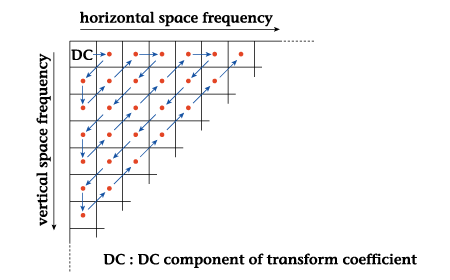 |
| Figure
17: Zigzag scanning |
(2) Arithmetic coding
The arithmetic coding
technique divides the
interval [0, 1] on the
number line into lengths
proportional to the appearance
probability of symbols
and allocates the symbols
in the stream targeted
for coding to their corresponding
partial intervals. This
division process is then
repeated, and the number
expressing the coordinate
of a point in the finally
obtained interval as a
binary fraction is taken
to be the code of that
symbol stream. The longer
the stream becomes, the
closer the average code
length gets to entropy.
The main purpose of arithmetic
coding is to code binary
data, but it can also
be used to turn multi-value
information sources (like
pictures) into binary
data. Arithmetic coding
expressly for multi-value
use is also being studied.
(Dr. Yoshiaki
Shishikui)
|

 between pels separated by
m pels horizontally and
n pels vertically as follows,
where the interval between
sample points is taken to
be x0, y0.
between pels separated by
m pels horizontally and
n pels vertically as follows,
where the interval between
sample points is taken to
be x0, y0.  and defined as follows.
and defined as follows.
 constitute a Fourier transform
pair according to the Wiener-Khintchine
theorem. This means that
a signal with high autocorrelation
like a picture signal concentrates
power in the low-frequency
domain. Letting
constitute a Fourier transform
pair according to the Wiener-Khintchine
theorem. This means that
a signal with high autocorrelation
like a picture signal concentrates
power in the low-frequency
domain. Letting  ,
,
 , and
, and  in Eq. (5), the two-dimensional
power spectrum becomes after
a Fourier transform.
in Eq. (5), the two-dimensional
power spectrum becomes after
a Fourier transform. derived by Conner and
Limb that deals with moving
picture signals. In this
regard, they created a
model of a moving picture
signal that considers
object speed or the camera's
aperture effect, accumulation
effect, etc., and derived
autocorrelation based
on that model. They also
showed that spatial correlation
along the direction of
motion increases as object
speed increases, but that
temporal correlation decreases.
derived by Conner and
Limb that deals with moving
picture signals. In this
regard, they created a
model of a moving picture
signal that considers
object speed or the camera's
aperture effect, accumulation
effect, etc., and derived
autocorrelation based
on that model. They also
showed that spatial correlation
along the direction of
motion increases as object
speed increases, but that
temporal correlation decreases.



















 , which is to be localized
in either time or frequency.
, which is to be localized
in either time or frequency.






